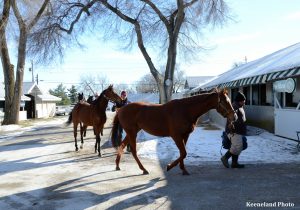 The Keeneland sales can be an overwhelming experience for the uninitiated and initiated alike, with 49 barns full of horses, selling on numerous days, with horses continually shipping in and out and various types of thoroughbreds available: in-foal mares, barren or maiden mares, broodmare and racing prospects, weanlings, and even geldings, stallions, and among these both racing and stud prospects. With luck, there may even be a mare who has already foaled, and will be brought through the ring with her new baby at her side, a rare two-for-one deal that both takes the guesswork out of foaling a mare whose habits you don’t know, and getting the late Christmas present of the cutest thing in the world, a new foal.
The Keeneland sales can be an overwhelming experience for the uninitiated and initiated alike, with 49 barns full of horses, selling on numerous days, with horses continually shipping in and out and various types of thoroughbreds available: in-foal mares, barren or maiden mares, broodmare and racing prospects, weanlings, and even geldings, stallions, and among these both racing and stud prospects. With luck, there may even be a mare who has already foaled, and will be brought through the ring with her new baby at her side, a rare two-for-one deal that both takes the guesswork out of foaling a mare whose habits you don’t know, and getting the late Christmas present of the cutest thing in the world, a new foal.
The January sale is known to be a cull sale, though not in a pejorative sense, because animals that such renowned entities as Juddmonte, Darley, Adena Springs, Hill ‘n’ Dale and others want to get rid of are spectacular buys for the rest of us. Also, should you want to pinhook, the January sale is ideal, as it represents the shortest turnaround time possible. Short yearlings  purchased at January can be turned around in September or October, and mares and new foals can be turned around in November. If you’re looking for a quick return on your investment, the January sale can’t be beaten. As well, because of the tendency for the weather to be utterly miserable (I’ve driven to the sale in blizzards), attendance is usually far sparser than for the more popular November sale.
purchased at January can be turned around in September or October, and mares and new foals can be turned around in November. If you’re looking for a quick return on your investment, the January sale can’t be beaten. As well, because of the tendency for the weather to be utterly miserable (I’ve driven to the sale in blizzards), attendance is usually far sparser than for the more popular November sale.
Even a relatively small sale like the January Keeneland sale demands strategy and efficiency, though, if you are a serious buyer. The Keeneland backside occupies many acres, stretching from right outside the sale pavilion to a good mile walk uphill to barn 49, so organizing your trek through the barns is essential. Sales companies such as Taylor Made and Eaton Sales are given prominent barns, with stock generally separated into mares and short yearlings, which are then separated into colts and fillies, to avoid potential hijinks by already studdish colts.
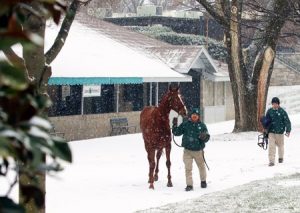 As well, once you make the decision to visit a sales company’s barn, you must have a list of the animals you want to see—you will be handed a card listing all of the company’s offerings, and must check off those that you want to see, and then wait your turn on one of the many walking areas to see your choices and make notes on them. Each sale company hires a variety of workers for the sale, making the backside a beehive of activity, with grooms, stall cleaners, those who actually show the animals to you, honchos with notebooks full of the details you require (x-rays and scopes on short yearlings, and information on mares’ pregnancy records, family updates, etc.), and the “clerks” who hand out, then collect your cards, and organize your viewing for you. This parade of workers follows each hip number into the back walking ring, into the sales pavilion’s walking ring, and then into the ring itself. It’s an amazing display of organization and safety, though an occasional animal will act up and demand extra help.
As well, once you make the decision to visit a sales company’s barn, you must have a list of the animals you want to see—you will be handed a card listing all of the company’s offerings, and must check off those that you want to see, and then wait your turn on one of the many walking areas to see your choices and make notes on them. Each sale company hires a variety of workers for the sale, making the backside a beehive of activity, with grooms, stall cleaners, those who actually show the animals to you, honchos with notebooks full of the details you require (x-rays and scopes on short yearlings, and information on mares’ pregnancy records, family updates, etc.), and the “clerks” who hand out, then collect your cards, and organize your viewing for you. This parade of workers follows each hip number into the back walking ring, into the sales pavilion’s walking ring, and then into the ring itself. It’s an amazing display of organization and safety, though an occasional animal will act up and demand extra help.
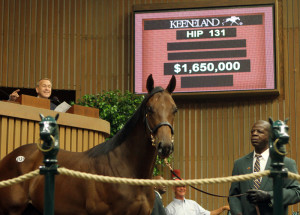 Clearly, you can’t see everything, so a serious, analytical reading of the catalogue is the first step in selecting those pedigrees that appeal to you (along with birthdays for yearlings, breeding dates for mares, and an attempt to foresee which animals will be in your price range) and are, therefore, worth looking at. In the January Sale in particular, I look for animals that seem slightly misplaced, and might slip between the cracks, yielding great bargains.
Clearly, you can’t see everything, so a serious, analytical reading of the catalogue is the first step in selecting those pedigrees that appeal to you (along with birthdays for yearlings, breeding dates for mares, and an attempt to foresee which animals will be in your price range) and are, therefore, worth looking at. In the January Sale in particular, I look for animals that seem slightly misplaced, and might slip between the cracks, yielding great bargains.
After high-selling, high profile animals, there will frequently be a dead spot. Very early in the sale is also frequently dead. And don’t forget lunch time, when carousing in the Keeneland dining areas distracts some buyers from the serious business at hand. I once purchased a small, hairy Red Ransom yearling colt in January for $5,000, and sold him at Keeneland September for $25,000. My best buy, a Time for a Change short yearling with a gorgeous pedigree but a late birthday, was hammered down to me for only $1500, and I sold him at the summer Texas yearling sale just a few months later for $40,000. I also purchased a Robin des Pins colt, a gorgeous, big chestnut with a quality page, for $7000, and likewise sold him at the Texas yearling sale for $40,000.
Though deals such as these are far rarer these days (note the late Jurassic period sires mentioned), pinhooking stand outs are still possible. It should be noted, however, that I had my own fully equipped farm, so I incurred no boarding fees, and no sales prep fees, as I had the capability of prepping for myself. Sales prep for yearlings is ridiculously expensive and labor intensive, and must be factored into the possibility of profit. My only expenses were feed, hay, farrier, vet and supplies, and my investment of my own sweat on a daily basis.
 One more thing to be aware of before putting time and energy into traversing the Keeneland barns: you must be able to make split second decisions when bidding, because each animal, except for the very high-priced ones, is only in the sales ring for three minutes. (I’ve clocked it.) So you must disregard the nerves inherent in the process and rapidly figure out if you should put your hand up. You must know your financial limitations, and stick with them, and trying to figure out whom you’re bidding against is useful. Remember that reserves are placed on most animals by the sellers and consignors, so bidding too quickly may result in your bidding against a reserve instead of a real, live, human bidder. But if you wait too long, you will lose out.
One more thing to be aware of before putting time and energy into traversing the Keeneland barns: you must be able to make split second decisions when bidding, because each animal, except for the very high-priced ones, is only in the sales ring for three minutes. (I’ve clocked it.) So you must disregard the nerves inherent in the process and rapidly figure out if you should put your hand up. You must know your financial limitations, and stick with them, and trying to figure out whom you’re bidding against is useful. Remember that reserves are placed on most animals by the sellers and consignors, so bidding too quickly may result in your bidding against a reserve instead of a real, live, human bidder. But if you wait too long, you will lose out.
I’ve attended the sale with clients who wanted to buy, but took too long to make up their minds, and the animals they wanted ended up going home with someone else, whose veins filled with ice water allowed them to triumph while indecisive buyers were left to parse why they got left out. It’s also worth paying attention to the Keeneland employees who bring the tickets out for the new buyers to sign, because many tickets don’t come out—they go right back to the Keeneland office, meaning the horse went unsold. You can frequently go back to the barn and make a private deal for such animals, when sellers are disappointed that their offerings didn’t sell.
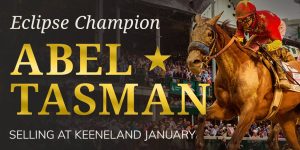 First off, when doing your pre-sale examinations at the barns, there are animals everyone will want to see. In this sale, there is one serious stand-out: Abel Tasman. The Champion and multiple Grade One winner is a must-see, for, as fans of racing, this is a once in a lifetime opportunity to view, close up, a great mare. The big race mares are a different species, and breathe more rarefied air.
First off, when doing your pre-sale examinations at the barns, there are animals everyone will want to see. In this sale, there is one serious stand-out: Abel Tasman. The Champion and multiple Grade One winner is a must-see, for, as fans of racing, this is a once in a lifetime opportunity to view, close up, a great mare. The big race mares are a different species, and breathe more rarefied air.
A few years ago, while I stood in the back walking ring, a huge, gorgeous, queenly mare came in, and I said to my companion, “that’s what a thoroughbred mare should look like.” When I checked my catalogue, I discovered she was Iotapa, a multiple graded stakes winner. Unforgettable. Others in that category were the enormous, fabulous Champion (and producer) Phone Chatter, and Tapit’s grand dam, the most adorable, chubby, little, doe-eyed, white mare I’ve ever seen, Ruby Slippers, for whom I had enormous horse lust. If you love good horse flesh, the sales are incomparable for these kinds of sightings and memories.
Abel Tasman is being sold by Taylor Made, the perennial leaders in sales results, partially because of their sheer numbers of offerings, but also because they tend to get such quality in their consignments. They are ultimate professionals, and it’s always a pleasure to visit their consignments. For Keeneland January 2019, Day One, Taylor Made has three barns, two, three and four, which are conveniently located just below the sales pavilion, making them a good starting place for your pre-sale examination safari. I usually start at those lowest barns, one through ten, and then move up to the second tier, 11, 12, 14, 15, 18 and 19 (the absence of 13 makes superstitious sense, but what happened to 16 and 17?), before heading up to the rest of the barns. Remember to factor into your meanderings the usual terrible weather in Lexington in early January, and dress accordingly.
 The card I’d fill out for Taylor Made consignment viewing would, of course, include Abel Tasman, though chances are that when you arrive at the barn, she will be out, being viewed, by many people. Look at her first—as the pre-sale attention goes on, she will become tired and aggravated, and your sense of her will be tainted by this. Paying attention to what others are looking at is important, because you might encounter something gorgeous that you hadn’t marked, but whose physical appearance is so stunning that you will be forced to consider it.
The card I’d fill out for Taylor Made consignment viewing would, of course, include Abel Tasman, though chances are that when you arrive at the barn, she will be out, being viewed, by many people. Look at her first—as the pre-sale attention goes on, she will become tired and aggravated, and your sense of her will be tainted by this. Paying attention to what others are looking at is important, because you might encounter something gorgeous that you hadn’t marked, but whose physical appearance is so stunning that you will be forced to consider it.
Also, if you know the players at all, seeing someone semi-famous to sales aficionados, with a big bank account, looking at one of your choices will save you the time of looking—clearly, that animal is unaffordable. Bob Baffert is, of course, one of these sale celebrities, but you should also be able to recognize such important players as Donato Lanni, David Ingordo, and anyone from the Coolmore crew or the posse of Sheikh Makhtoum.
Here is a sampling of what I’d look at for the sale’s first day at the Taylor Made barns, and why:
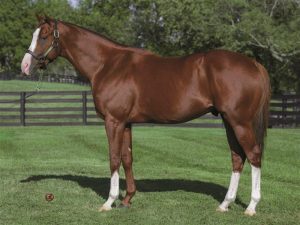 38: A Will Take Charge yearling colt, early enough birth day to have size, in-breeding to Somethingroyal, tail female La Troienne. The page of Kentucky Derby winner Sea Hero. The Will Take Charge offspring tend to be big and handsome, like dad.
38: A Will Take Charge yearling colt, early enough birth day to have size, in-breeding to Somethingroyal, tail female La Troienne. The page of Kentucky Derby winner Sea Hero. The Will Take Charge offspring tend to be big and handsome, like dad.
39: An Into Mischief yearling colt, foaled February 4, with a minor black type dam. The third dam, however, is unbeaten super-mare Personal Ensign, who engendered a line of champions and millionaires that is still potent. A no-brainer.
45: Miss Pleasant, by Pleasantly Perfect, twelve years old, room for only the first dam on the page. Her first foal was a stakes winner by Congrats, and she is in foal to Malibu Moon on a February 23 cover. She herself was a stakes winner, and graded stakes placed. The only thing that could make this better is if she has her new foal already by her side.
71: Paris Bikini, a six-year-old Bernardini mare, in foal on a March cover to Distorted Humor, whose third dam is the Juddmonte Blue Hen Blush with Pride, a family that is very hard to buy into. Blush with Pride is the only mare to have produced two Belmont S-G1 winners, the filly phenom Rags to Riches and Jazil. Paris Bikini has a 2017 Curlin filly and a 2018 Into Mischief colt—she is all potential. Another no-brainer.
107: Liam’s Map yearling filly, foaled February 9, out of a Storm Cat mare—Unbridled’s Song on Storm Cat works beautifully. Add in a Holy Bull second dam, for more of the In Reality/Dr. Fager line that Liam’s Map is so rich in, plus a champion Mr. Prospector fourth dam, Tersa. Great page, and the first offspring of Liam’s Map have been very well received. I’ve seen him, and love him.
118: Ruby’s Realm, a 2006 Empire Maker mare, whose dam, stakes winner Ruby Ransom, produced millionaire Strut the Stage, and whose daughters have produced. Ruby’s Realm has already produced a small stakes winner, has a 2017 Honor Code about to hit the track, and is in foal to Twirling Candy, with a great nick—nothing Twirling Candy likes better than more Fappiano. And Ruby’s Realm’s third dam? Myrtlewood Lass, making her a part of the same tail female family of Mr. Prospector, Seattle Slew, and Forestry. Love this page.
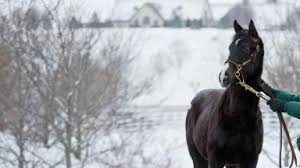 Of course, it goes on and on—Taylor Made’s consignments are always gold mines. And this is just the start—you haven’t even trekked up the hill yet. You need a system, and it helps to have some guiding theories. I like the classic female families, of course, and having made a yearly effort to look at both new and old stallions in the flesh, I have certain favorites. A spectacular looking young stallion, as Will Take Charge was when I first saw him, and as Liam’s Map and Honor Code are, makes a big impression, and I would love to be able to invest in any of those. And of course, certain broodmare sires are favorites: Empire Maker chief among them, but also Bernardini and Malibu Moon, and many from the Storm Cat line.
Of course, it goes on and on—Taylor Made’s consignments are always gold mines. And this is just the start—you haven’t even trekked up the hill yet. You need a system, and it helps to have some guiding theories. I like the classic female families, of course, and having made a yearly effort to look at both new and old stallions in the flesh, I have certain favorites. A spectacular looking young stallion, as Will Take Charge was when I first saw him, and as Liam’s Map and Honor Code are, makes a big impression, and I would love to be able to invest in any of those. And of course, certain broodmare sires are favorites: Empire Maker chief among them, but also Bernardini and Malibu Moon, and many from the Storm Cat line.
Being able to sort out what you will probably like, from what you don’t believe in, is a great start in culling hip numbers from the catalogue that you won’t want to look at. Being able to read and analyze a catalogue page quickly is a must, as occasionally a horse comes through the ring that isn’t garnering the attention it should—figuring out why, and if the bidders are making a mistake that you might be able to take advantage of during those three minutes she is in the ring, may provide you with a chance at a terrific bargain.
Exhausting, amazing, horseflesh more gorgeous than you have ever imagined—the Keeneland Sales are too fascinating and too much fun. Plus getting to see the very wealthy bid against one another, bidding more in one raise of an index finger than I have in my total bank account, is an experience that boggles the mind. Everyone should go to a Keeneland Sale, just for the experience, but if you’re not intending to buy, be prepared to sit on your hands and catch nobody’s eye. Or you could go home with a horse.
— Roberta Smoodin